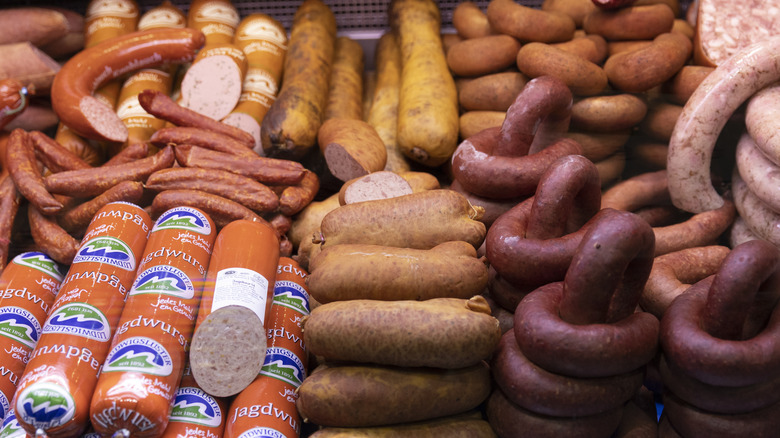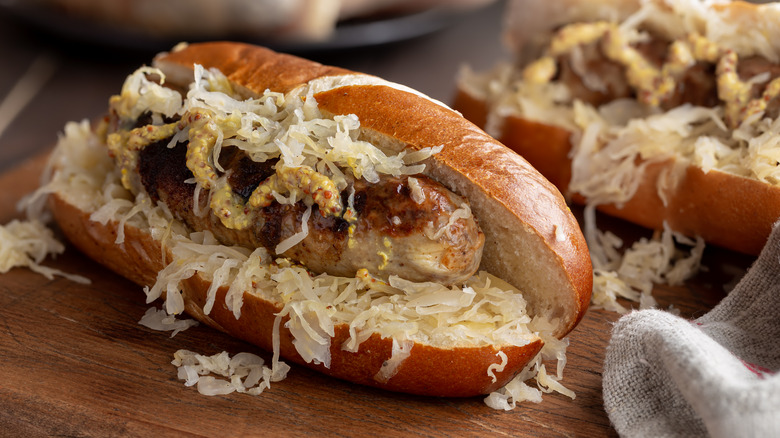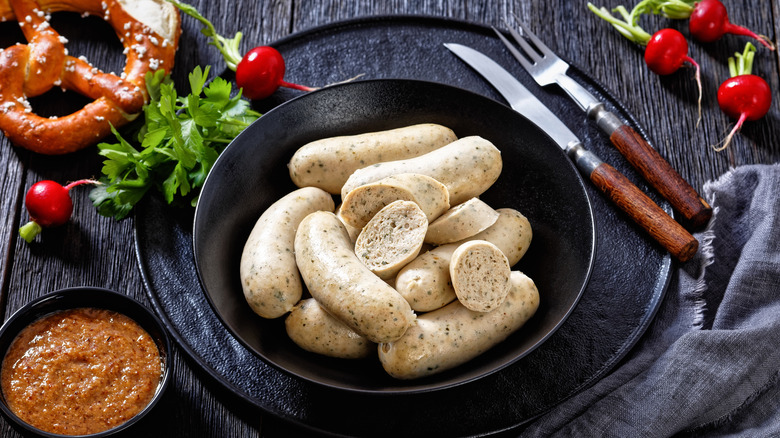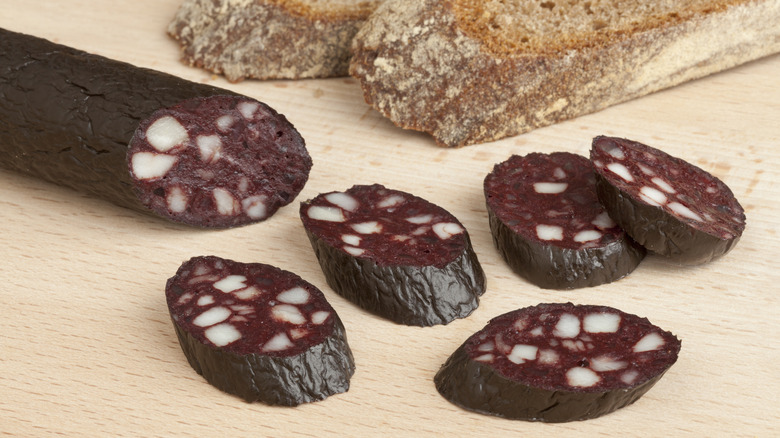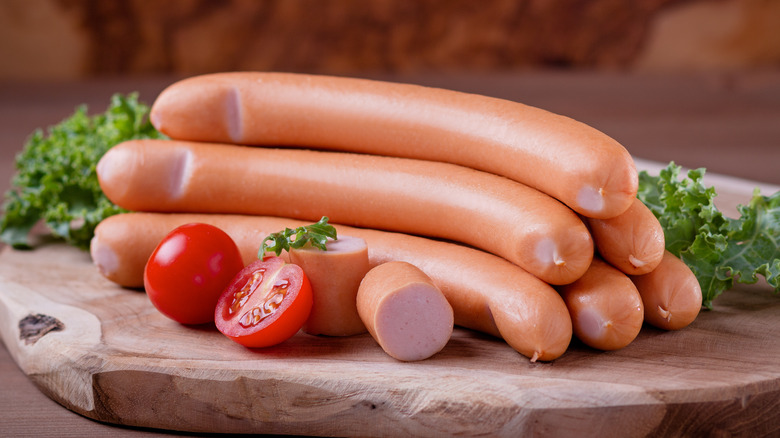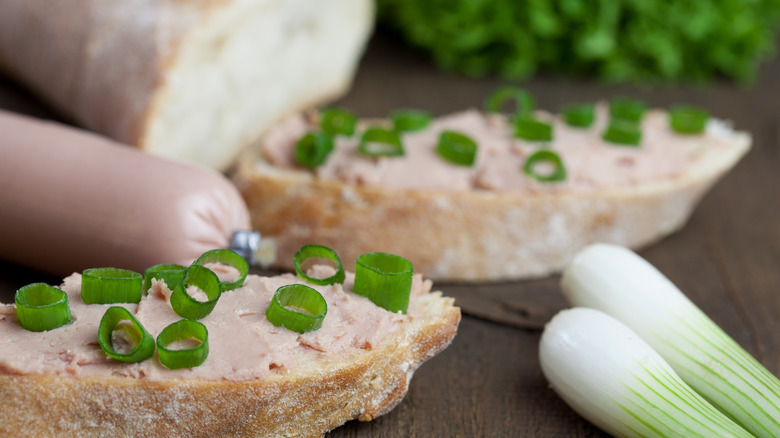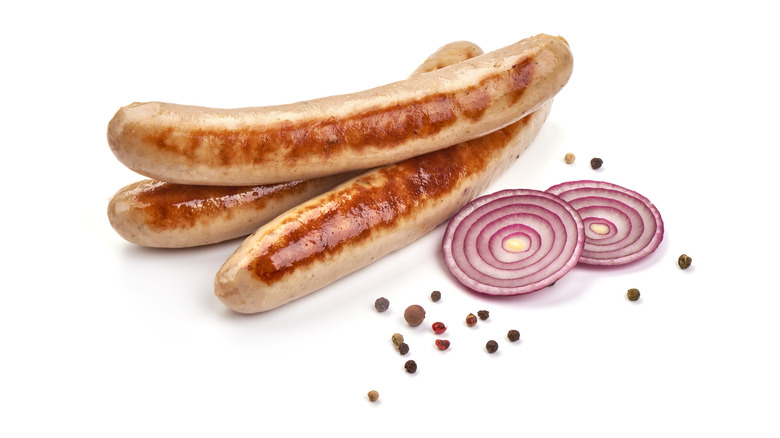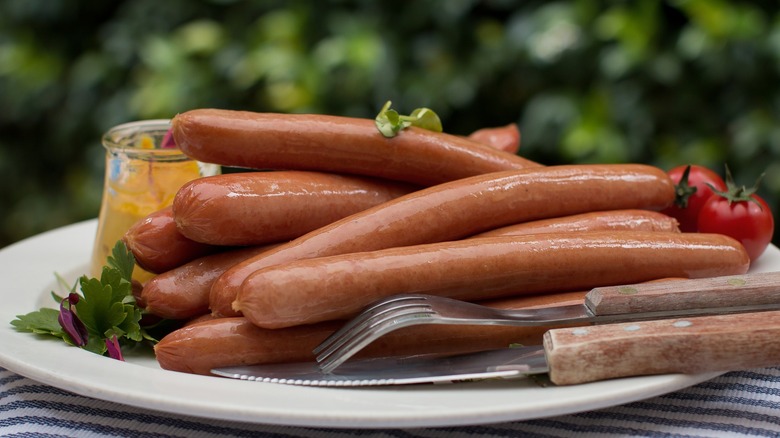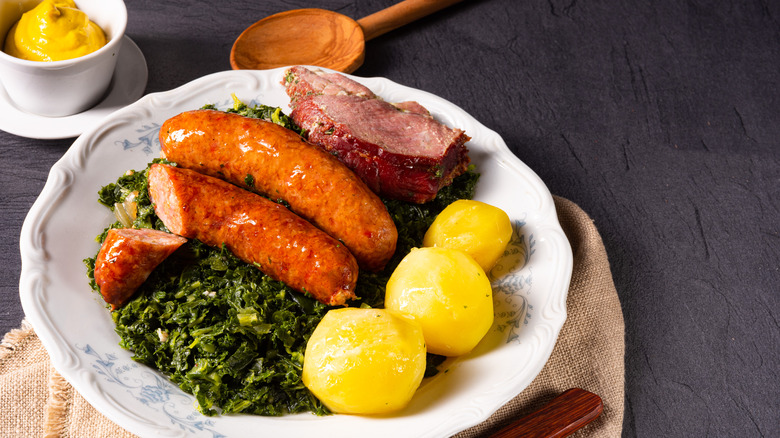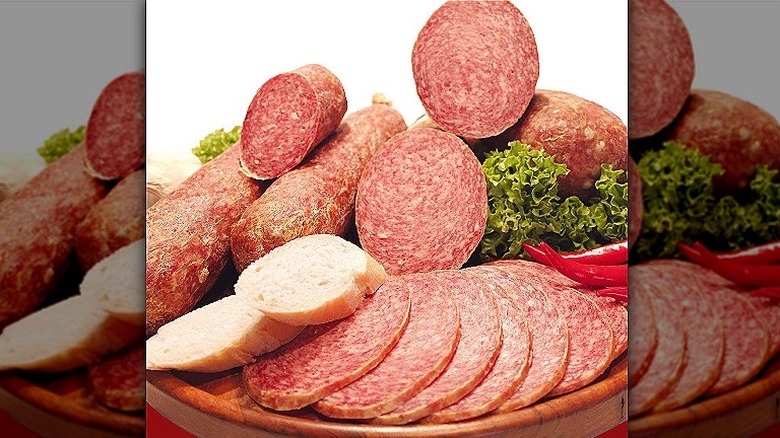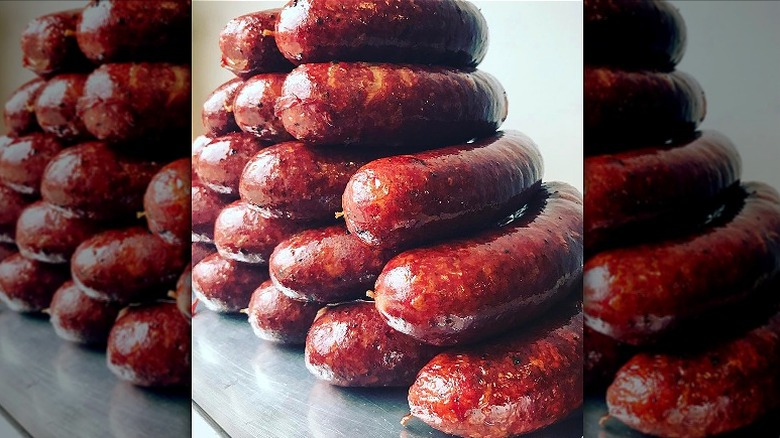The Ultimate Guide To German Sausages
It would be impossible to imagine a world without sausages — indeed, they are food items consumed by cultures across the globe. The earliest known documentation of sausage–making comes from Sumerian texts dating back 4,000 years ago, in which all types of meat got stuffed into intestinal casings, including pickled grasshoppers. Sausage, coming from the Latin salsus or "salted," are a type of forcemeat, meaning meat of any kind being finely chopped or ground with various seasonings, blood, or grains and then forced into a casing. These are cooked, dried, fermented, smoked, or salted to inhibit the growth of bacteria and provide a reliable food source throughout the year.
Perhaps no single country has embraced the art of sausage-making quite as voraciously as Germany. In Germany, sausages were made as early as 500 B.C. The earliest specimens contained pork, spices, and offal, which was stuffed into sheep intestines before being boiled or smoked. Sausage-making enabled Germans to not only use every part of an animal without wasting it but was a food that was equally accessible and respectable for those of all socio-economic statuses. In a way, it united Germans around a cultural food identity.
Today, Germany has a dizzying array of more than 1,200 types of sausages made of various kinds of meat. Each of these hail from distinct regions, displaying unique ingredients and microclimates of that region. The following sampling represents just a drop in the bucket of German sausages but offers a glimpse into the diversity of flavors, sizes, and cooking styles they represent.
Bratwurst
While the precise origin of the most popular sausage eaten in Germany, Bratwurst, is unknown, it has been consumed by Germans for centuries. Its name is assumed to come from High German, although the exact translation of the word "brät" has several meanings associated with it, from "finely chopped meat" to "roasted" to "without waste." The term wurst means sausage. Earliest renditions of this sausage were made with scraps of pork stuffed into intestinal casings, allowing Germans to endure the brutal winters typical of Germany.
These sausages today are made with ground pork (occasionally beef or veal) seasoned with spices like coriander, ginger, pepper, mace, and nutmeg, among others. These often get stuffed into synthetic casings rather than natural ones. There are approximately 40 different iterations of a brätwurst today, with many hailing from the south-central region of Germany known as Franconia. This region is well-known for its earthy dry white wine Sylvaner, which pairs beautifully with a brätwurst.
While bratwurst can be eaten on its own with some German mustard on crusty bread, it is a regular breakfast dish served with potatoes, sauerkraut, and hard-boiled eggs. It also features as an element of various soups, stews, and casseroles. These sausages are typically smoked after cooking to give them a better flavor and snap.
Weisswurst
Weisswurst, or white sausage, is a quintessential Bavarian dish often associated with Munich. This sausage typically gets made from veal, pork, onion, parsley, bacon, salt, pepper, and lemon juice, giving it its pale color. It likely originated in 1857 – an innkeeper in Munich had to substitute tough pork casings for delicate sheep ones. Because the pork casings were inedible, these sausages got boiled instead of grilled for fear that the precious filling would explode if exposed to too much heat.
Today, there is a saying that weisswurst should not be eaten after noon, which is why it's enjoyed as part of a traditional Weisswurstfruehstueck, or white sausage breakfast. It is also commonly eaten with pretzels and Weisswurstsenf, or sweet mustard. The key is never to eat the casing. While most Germans will peel it as they eat the sausage, bite by bite, some are known to Zuzel or suck it out in a rather unrefined but utterly ceremonious way. And no matter how you eat it, the appropriate beverage to accompany this delicacy is a Bavarian weissbier, or white beer, like a hefeweizen, an unfiltered wheat beer.
Connoisseurs caution that this sausage should never be boiled but simmered gently for approximately 10 to 15 minutes to avoid them exploding or becoming watered down, thus muting its delicate flavor. They can be grilled or pan-seared before eaten and should always be enjoyed warm.
Blutwurst
Blutwurst, or blood sausage, is perhaps one of the more controversial sausages around. The earliest renditions of this delicacy got described by Homer in The Odyssey. They began as a solution to feed people during war or famine, where all parts of an animal would get used, combined with blood and a binder like barley. Because this is a cooked sausage, it can be served hot or cold and comes in two varieties, sliced and whole.
Sometimes known as Tote Oma, or "dead grandma" in German, this sausage prompts mixed reactions when served. It is most definitely an acquired taste and texture. Its flavor is quite aggressively iron-forward with a noticeable aftertaste. It has a mouthfeel ranging from soft to gristly, as often little pockets of fat or other organ meats pop up in a bite giving it a noticeable crunch. Its color ranges from a reddish brown to deep mahogany contingent upon how much and what kind of blood is used.
Some common ways of eating this sausage include putting it on a charcuterie board, adding it to eggs, and eating it alongside sauerkraut with french fries and applesauce. However you decide to eat it, start with a small piece — ease into it. It can be delicious once you get past what is in it. And don't eat a lot of it at a time. It is rich, a once-in-a-blue-moon treat under the right circumstances.
Frankfurter Würstchen
Whether you call them Vienna sausages, wieners, franks, or hot dogs, Frankfurter Würstchen is a slow-smoked pork sausage originating in Frankfurt, Germany. While its precise origins are unknown, there has been a variation of a sausage made in Frankfurt dating back to the Middle Ages, known as Frankfurter Bratwürstchen. These more rustic sausages were staples during the coronation ceremonies of German emperors from 1562-1792, giving them the moniker of Krönungs Würstchen, or "coronation sausages."
Beginning in the 1860s, the term Frankfurter Würstchen became protected, and by 1929 it was illegal to call anything a Frankfurter Würstchen that did not get made in the area surrounding Frankfurt. While the modern-day hot dog is made with beef and pork, a true Frankfurter Würstchen is only made of pork because, in the 19th century, pork and beef butchers were not interchangeable. They were unique occupations that weren't combined.
Because Frankfurter Würstchen comes cooked, you should warm it before eating them. They should get simmered for around 10 minutes before consumption — not boiled — to avoid the meat exploding from the casing. Frankfurter Würstchen is generally eaten with a crusty bread called Brötchen or rye bread, or accompanied by a classic German potato salad. A frequent beverage paired with this sausage is a glass of Apfelwein, a sparkling apple wine made of heirloom apple varieties without any sugar added, making it slightly tannic and tart.
Leberwurst
Leberwurst, or liver sausage, is another very popular sausage in Germany. Its regional variability is high, with pork being the primary meat used, although beef, veal, or poultry can be incorporated. This sausage is similar to a French paté — it is relatively creamy and often gets smeared atop bread or crackers. Common spices added to the blend of liver, organ meat, and fat, include salt, pepper, marjoram, allspice, thyme, mustard seeds, nutmeg, coriander, and onion powder. Most recipes include 10-35% liver content in the blend, giving it a more or less aggressively mineral-forward flavor. Once the sausage is formed, it's boiled before being cooled and refrigerated.
One unique regional specimen of leberwurst includes Thüringian, which is distinct in that they are geographically protected. At least 51% of the production of these sausages must occur in the central state of Thüringia. These sausages are made of pork and are cold-smoked with beech wood. Another variation comes from the southwestern region of Palatine. This leberwurst adds pork connective tissues and meat from the head to the liver. No other organ meat can get added per the German code of production. Pork belly may also be added in some instances.
Leberwurst shines paired with pickles and good mustard, as the acidity from the pickling spices and heat from the mustard help to balance the fat content in this sausage. Additionally, it can be sliced and pan-fried or grilled for a delightful delicacy. These cooked slices can be added atop salads, tossed into potato casseroles, or served with crusty bread and a hint of sauerkraut.
Thüringer Rostbratwurst
Like Thüringian leberwurst, Thüringer Rostbratwurst is a sausage from the central German state of Thüringia that has been granted protected geographical indication (PGI) status under European law. The PGI status means that no less than 51% of the ingredients used in producing this sausage must be sourced from the region. Thüringer Rostbratwurst is a sausage typically made of pork, although beef or veal can be used. Its flavor and spice profile are similar to a regular bratwurst, although it is relatively low in fat content, approximately 25%, making it a bit precocious to cook with. Seasonings often include salt, pepper, caraway seeds, marjoram, and garlic, with the occasional appearance of nutmeg, coriander, and lemon zest for pop. These sausages are relatively spicy and have a distinctive thin, long shape, ranging from 6 to 8 inches long.
Their history dates back about 600 years, with the first recorded mention of the sausage occurring in 1404. The earliest documented recipe appeared in 1613, with another recipe for a smoked variation described in the 1797 Thüringer-Erfurt Cookbook. These sausages are most commonly cooked over a wood-fire grill that has been basted with bacon fat to keep them from sticking. They can also be pan-seared and basted with beer to prevent the sausages from splitting over high temperatures. The best way to enjoy these sausages is served open-faced on a roll, or Brötchen, with mustard and a hearty German potato salad.
Gelbwurst
Gelbwurst, or yellow sausage, comes from the southeastern state of Germany known as Bavaria. It is a sausage predominantly made of pork and bacon, although often veal can be added. It historically got its distinctive color from using saffron to dye the intestinal casing — although today, less expensive yellow dyes using ingredients like turmeric are more common. This sausage is generally spiced with nutmeg, ginger, cardamom, salt, pepper, and lemon, with parsley occasionally added. The filling is pulverized into a smooth paste, giving this sausage a distinct texture ideal for slicing into cold cuts. The color of the meat itself is a neutral grayish hue, with a mild flavor ideal for sandwiches.
This sausage is also called Hirnwurst or "brain sausage," as it was historically made with pig brains composing up to 25% of its volume. While this is no longer the case, the name has stuck nonetheless. When eating Gelbwurst, avoid eating the casing. And please note that this is a sausage with a very short shelf-life, so it should get consumed within a couple of days of purchasing it.
Bockwurst
Contrary to its name, Bockwurst is not a goat sausage (Bock meaning goat in German). It is a svelte sausage made primarily of veal and some pork, seasoned with milk, eggs, chives, parsley, salt, white pepper, and paprika. It is encased in pig or sheep intestines and gently smoked. Bockwurst is a juicy sausage with pale color that often gets served grilled or fried with bread, mustard, potatoes, and gravy. It's always accompanied by a bockbier, a dark, lightly hopped beer with a high alcohol content — this became popularized in Southern Germany in the 1800s by Bavarian monks who served it during the fasting season of Lent and Easter.
The origins of Bockwurst are slightly ambiguous, but the most commonly touted legend is that it got invented by a Jewish butcher named Benjamin Löwenthal. In 1889 a pub owner in Berlin named Richard Scholz was commissioned to host a gathering for students at the local university. To serve something special, Scholz sourced this distinct sausage from the butcher and fed it to the students with a strong bockbier. The students loved the delicacy so much that they pronounced it "bockwurst." The rest is, well, history (presumably).
Pinkel
Pinkel is a type of Grützwurst, or sausage that, alongside blutwurst, contains groats (oats). This sausage is made of pork, bacon, onions, salt, and pepper stuffed into pork intestines and smoked. The Pinkel hails from Northwest Germany, especially villages surrounding Oldenburg, Bremen, Osnabrück, East Frisia, and Friesland. Its name means "little finger" in East Frisian, presumably referencing its small size. One variation of Pinkel is called Fleisch-Pinkel (meat Pinkel) or Oldenburger Pinkel, which contains distinctly high proportions of meat in their recipe.
What makes this sausage particularly interesting is a traditional method of being cooked in a recipe called "Kohl und Pinkel," or kale and Pinkel. "Kohl und Pinkel" is a specialty native to the city of Bremen, where every winter, locals embark on a kind of pilgrimage known as the Kohl und Pinkelfahrt. It is during this time that kale is at its peak. Hand carts are hauled throughout the fields and streets and filled with this green leafy delicacy while participants fortify themselves against the cold with generous quantities of Schnapps. The day includes frivolity, community, and eventually a piping hot bowl of the pièce de résistance, the "Kohl und Pinkel."
Mettwurst
Mettwurst, or Metwurst, is classified as a Rohwurst, or uncooked sausage, that originated around 500 years ago. Its name comes from the German "mett" or "minced pork." It is a sausage predominantly fashioned from pork and occasionally includes veal or beef that is more or less finely ground depending upon the region and its most common recipe. The meat can be seasoned with salt, pepper, garlic, ginger, mustard, paprika, marjoram, caraway seed, allspice, mace, and cardamom, but occasionally may contain alcohol, like rum or cognac. Once the mixture is tucked into its pork casings, it gets cured, like salami, before being smoked using either a hot or cold smoking process, depending upon taste.
The resulting sausage is a somewhat extended, svelte, cooked sausage that can range from hard with a distinct snap in the North to a softer, more spreadable creamy sausage in Southern Germany. Because of this smoking process, the flavor of this sausage is quite aggressive and aromatic. Mettwurst does not need to be cooked before eating it, as it comes fully cooked. The soft spreadable variation is typically put on sandwiches or served as an appetizer with crackers. The sturdier Northern variation is often added to stews or soups with cabbage or kale.
Leberkäse
For a crash course in German linguistics, let's look at a classic Leberkäse, or "liver cheese." This delicacy, originating in Bavaria in Southern Germany, is a meatloaf made of corned beef, pork, bacon, and onions that are deftly ground together into a smooth mixture before being baked. Its caramelized exterior is part of the appeal of this specialty, which is enjoyed in several ways, including a sandwich with mustard, pan-fried with an egg on top, and turned into a mock Cordon Bleu (false Cordon Bleu), where it gets flanked with ham and cheese, battered, and fried.
The complexity of this delicacy, which has been around for more than 200 years, is that it has neither liver nor cheese in the mix. Its name originated with the word "Laib," or "loaf," and "Käse," or "cheese-like," which aptly describe its shape and texture. The irony is that outside of Bavaria in other parts of Germany, Leberkäse does have some liver, making it confusing for tourists to decipher what they might be eating. Muddying the waters even further are other versions of Leberkäse, including Pferdleberkäse, which contains horsemeat, Käseleberkäse dotted with chunks of cheese, and Pizzaleberkäse, which throws the whole shebang at the Leberkäse, including cheese, red peppers, salami, and pickles.
Knackwurst
Knackwurst, or Knockwurst, is a sausage that has existed since the 16th century. It hails from a region of Northern Germany called the Holstein region. It is a short, fat sausage ranging from 1-1/2 to 2 inches long. A classic Oktoberfest dish, this is a sausage that lends itself to being grilled or smoked. It's often paired with mustard, sauerkraut, spaetzle, or potato salad, and a pint of German beer.
Its name derives from the German word "knachen," or "to crack," adequately describing the distinct sound this sausage makes when its skin gets crispy after being cooked. Knachwurst is a sausage made of pork, veal, garlic, and sometimes beef, along with spices. Once encased, the knackwurst is aged for several days before undergoing a smoking process using oak wood. It may appear similar to brätwurst at face value, but it is distinct due to its inclusion of veal. It also has a unique rust color rather than a delicate pink hue characteristic of brätwurst.
Landjäger
For lack of a more sophisticated way of describing this delicacy, Landjäger is a type of sausage most similar to beef jerky. It is native to southern Germany, Switzerland, Austria, and Alsace. It is a sausage typically made of beef, pork, lard, sugar, red wine, and spices. These get fashioned into links roughly 6 to 8 inches in length before getting molded into a rectangular shape just under an 1 inch diameter. These are then slow-smoked over hardwood before undergoing a long curing process, rendering them shelf-stable.
This method of preparation is the inspiration for the origin of its name, which means "land hunter," and likely evolved from the German expression "lang tige," or "smoked for a long time and air-cured for a long time." While these would have been an ideal snack for a hunter, they got popularized by soldiers needing rations that would keep without refrigeration. While they are usually eaten as is with bread, mustard, and potato salad, they can also be cooked into stews with potatoes and greens.
Braunschweiger
Braunschweiger is a type of liver sausage or paté-like mixture originating in the German city of Braunschweig or Brunswick, located in Northwestern Germany. While it is similar to and often mistaken for Leberwurst, it's different. This sausage is primarily made of pork, although sometimes beef is added. It must contain at least 30% liver with no other organs added. This meat gets combined with bacon, onion, salt, pepper, garlic, nutmeg, ginger, and cardamom and ground into a paste that ranges from smooth to slightly more rustic. Once encased, it's then boiled and generally smoked, yielding a darker tan color and aggressive mineral-forward, smokey flavor.
This specialty can be eaten straight out of its packaging in a sandwich, as a spread for crackers, or added to various dips. It also works well in potato hash, added to meatballs, and fried in cubes that can be used to garnish a salad. And while not traditional, we have used it as a substitute for a French paté in a classic Beef Wellington recipe. It is a bit stronger in flavor, but when sparingly applied, it can give this dish a delightfully earthy, smoky flavor.
